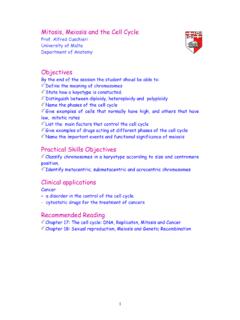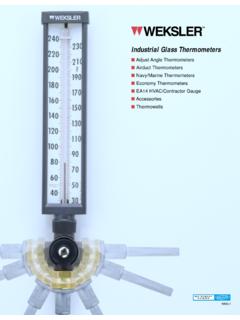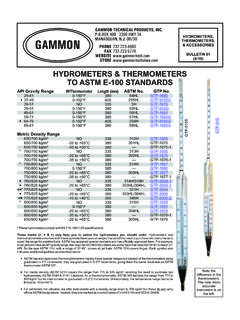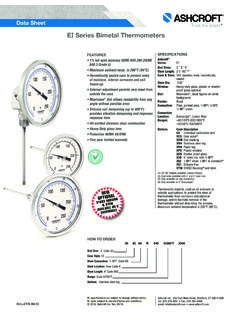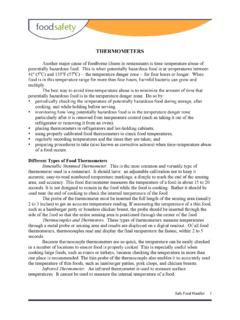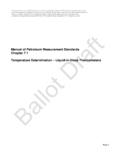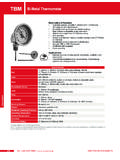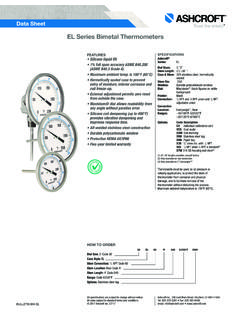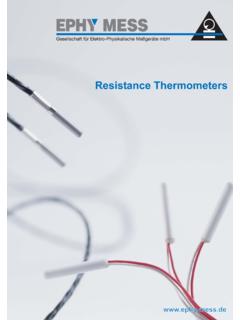Transcription of Types of Thermometers - Search
1 Thermometers 1 A thermometer is a device that measures temperature or temperature gradient, using a variety of different principles. The word thermometer is derived from two smaller word fragments: thermo from the Greek for heat and meter from Greek, meaning to measure. A thermometer has two important elements, the temperature sensor ( the bulb on a mercury thermometer ) in which some physical change occurs with temperature, plus some means of converting this physical change into a value ( the scale on a mercury thermometer ). Industrial Thermometers commonly use electronic means to provide a digital display or input to a computer.
2 Types of Thermometers The Liquid in Glass thermometer . The Liquid in Glass thermometer utilizes the variation in volume of a liquid in temperature. They use the fact that most fluids expand on heating. The fluid is contained in a sealed glass bulb, and its expansion is measured using a scale etched in the stem of the thermometer If we consider that the thermometer does not expand then as physical property it utilizes the variation of length of liquid with temperature. Liquid in Glass Thermometers have been used in science, medicine, metrology and industry for almost 300 years. Liquids commonly used include Mercury and Alcohol. Structure: Two basic parts: a.
3 The bulb: Acting as a reservoir holding the liquid whose volume changes with temperature. The Bulb also acts as a sensor or gauge which is inserted in the body whose temperature is to be measured. b. The Stem: containing the scale that is measuring the temperature and a capillary through which the liquid can accordingly expand and contract STEMC apillary Main ScaleExpansionChamber Contraction Chamber Auxiliary Scale Bulb 2 General Properties Advantages: 1. They are cheap to manufacture 2. Easy to carry and handle. Disadvantages: 1. They tend to have high heat capacities. They are not sensitive enough, that is they cannot measure rapid temperature changes.
4 The mercury in glass thermometer : Invented by German physicist Daniel Gabriel Fahrenheit, is a thermometer consisting of mercury in a glass tube. Calibrated marks on the tube allow the temperature to be read by the length of the mercury within the tube, which varies according to the temperature. To increase the sensitivity, there is usually a bulb of mercury at the end of the thermometer which contains most of the mercury; expansion and contraction of this volume of mercury is then amplified in the much narrower bore of the tube. The space above the mercury may be filled with nitrogen or it may be a vacuum. Range: Covering a wide temperature range from -38 C to 356 C, although the introduction of a strument can increase the range to 600 C or beyond.
5 Gas into the inAdvantages: 1. Mercury is a naturally opaque liquid (Silver). This means that it can be directly utilised in its pure form 2. Mercury does not wet glass. When it moves up and down in the capillary strong cohesive properties of mercury do not allow it to leave any traces on the inside of the capillary. 3. Mercury is a liquid metal. As a metal it has high conductive properties that allow it to be sitive than the alcohol in glass thermometer . more senDisadvantages: 1. Mercury poses a potential toxic hazard if the glass container is ruptured. The alcohol in glass thermometer : As a liquid it utilises ethyl alcohol, toluene and technical pentane, which can be used down to -200 C.
6 Range c. -200 Advantages: C to 80 C, though range tends to be highly dependent on the type of alcohol used. 1. It can meDisadvantages: as ure very low temperatures. 1. Alcohol is transparent therefore it requires a dye to make it visible. Dyes tend to add impurities that may not have the same temperature range as the alcohol making reading difficult especially at the limits of each liquid. 3 2. Alcohol wets glass. General Equation for Temperature calculation using a liquid in glass thermometer : L - L0 L100- L0 = X 100 The resistance thermometer Makes use of the change of resistance in a metal wire with temperature. As electrons move through a metal, they are impeded by the thermal vibrations of the atoms in the crystal lattice.
7 The higher the temperature the greater the impediment to flow thus the higher the resistance. This effect is very marked in pure metals, and for a well-behaved material enables measurements of temperature to be made to better than C. Usually platinum wire is used in the construction of the thermometer , since it is a noble metal which is un-reactive over a wide range of temperatures. But copper, nickel and rhodium alloy may also be used in various temperature ranges. Usually a coil of the pure wire is wound onto an alumina former or placed in the bores of an alumina tube, and this assembly is mounted in a steel tube.
8 Resistance Thermometers are slowly replacing thermocouples in many lower temperature industrial applications (below 600 C). Resistance Thermometers come in a number of construction forms and offer greater stability, accuracy and repeatability. The resistance tends to be almost linear with temperature. A small power source is required. No special extension cables or cold junction compensations are required. The resistance of a conductor is related to its temperature. Platinum is usually used due to its stability with temperature. The Platinum detecting wire needs to be kept free of contamination to remain stable.
9 A Platinum wire or film is created and supported on a former in such a way that it gets minimal differential expansion or other strains from its former, yet is reasonably resistant to vibration. Resistance Thermometers require a small current to be passed through in order to determine the resistance. This can cause self heating and manufacturers limits should always be followed along with heat path considerations in design. Care should also be taken to avoid any strains on the resistance thermometer in its application. Resistance Thermometers elements are available in a number of forms. The most common are: Wire Wound in a ceramic insulator - High temperatures to 850 C Wires encapsulated in glass - Resists the highest vibration and offers most protection to the Pt Thin film with Pt film on a ceramic substrate - Inexpensive mass production 4 Practical Construction Advantages 1.
10 Depending on the metal being used resistance Thermometers are able to cover extensive temperature ranges. Maximum values are generally related to the melting points of the metal used. 2. Variation of resistance with temperature is stable over an extensive temperature range. 3. Very accurate Disadvantages 1. Compared to liquid in glass Thermometers , they tend to be expensive. 2. Require other equipment to measure temperature. 3. They exhibit high heat capacities thus they are not sensitive to temperature change meaning that they cannot be used to measure rapid temperature changes. R - R0 = X 100 R100- R0 Thermocouples As a Thermometric property thermocouples utilise the variation of EMF generated at a bi-metallic junction with temperature.




